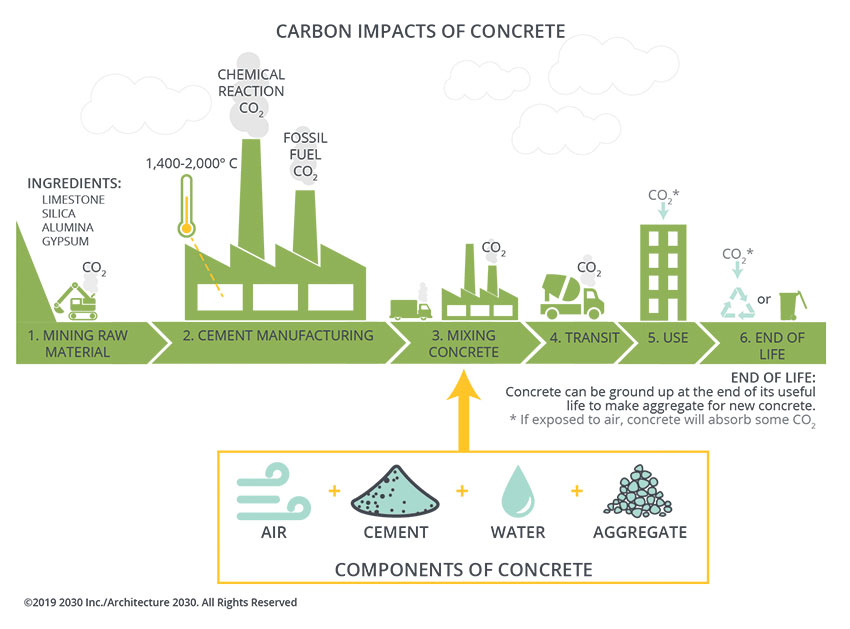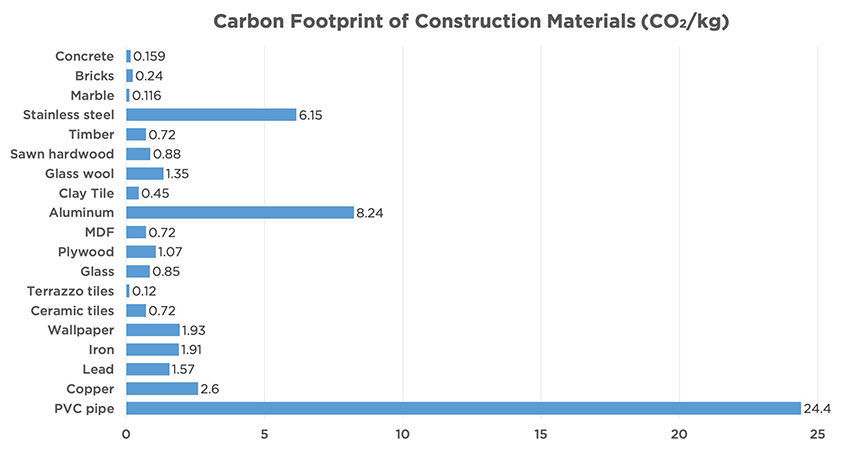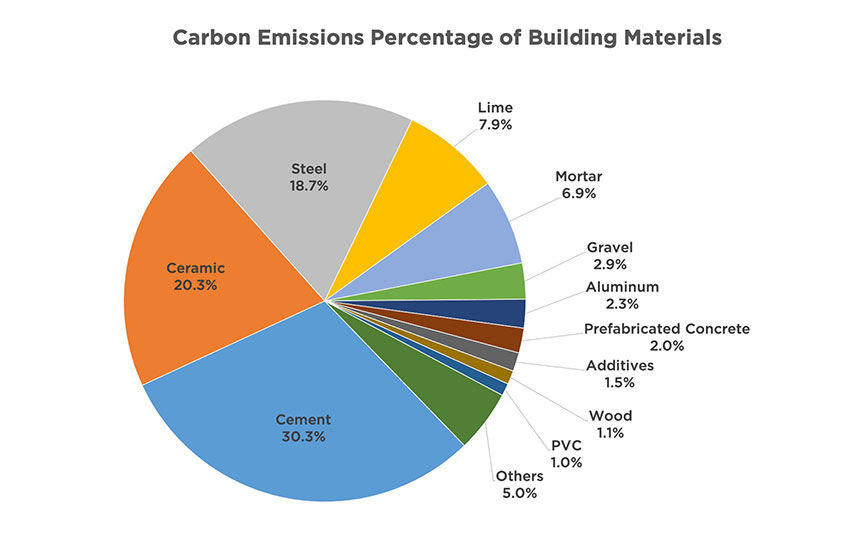The Climate-Positive Benefits of Concrete in Outdoor Architecture
THE MANUFACTURE OF CONCRETE, ITS USE WORLDWIDE, AND TECHNOLOGICAL ADVANCES
Cement or cementing materials date back to Roman mortars and concretes. But it wasn’t until the 1820s that Portland Cement was created and patented in England. Today’s concrete includes many types: normal strength, reinforced, pre-stressed, poured in place, precast, lightweight, high-density, and more. But the general manufacturing process is the same. Raw materials such as limestone silica, alumina, and gypsum are extracted from the earth. They are then heated at extremely high temperatures to create a chemical reaction called calcination. This reaction produces the clinker, which is mixed and ground to make cement. Cement is then taken to the concrete mixing facility (this could be the same site or a different location) and mixed with water, air, and aggregates to make the concrete. It is then transported to the location of use to create the built environment, either in a wet or cured format. To close the loop on its life cycle is the end of life, which for some concrete products can include reuse or recycling as an option.
The most significant CO2 impact happens during the creation of the cement. During cement manufacturing, emissions related to fuel use (to create the heat) account for 40 percent of the material’s total CO2 creation. The remaining 60 percent comes from quarrying, transport, cooling, and mixing, but mostly from process emissions which include the chemical reaction called calcination required to make cement clinker. Almost a pound of CO2 is emitted for every pound of cement. However, cement is only one ingredient in concrete. Some 85 to 90 percent of concrete is made up of other ingredients. That means 10 to 15 percent of the mixture is cement; the rest is water, aggregates, admixtures, and air.

Image courtesy of ©2019 2030 Inc./Architecture 2030. All Rights Reserved.
There is a difference between embodied carbon and operational carbon.
Concrete Alternatives
In the early 1990s, concrete manufacturers started to replace some of the cement in the mix with supplementary cementitious materials (SCM). Today, some manufacturers continue actively working to reduce the cement content in concrete, up to 55 percent in some cases. Manufacturers that don’t need freeze-thaw test ratings can replace even more cement. However, performance must be factored in. More cement is required to create concrete with high compressive strength, which means an excellent freeze-thaw rating, essential for durability in colder climates.
Potential replacements include:
- Pozzolans: Fly ash, volcanic ash, glass, and rice husk, to name a few, combine with calcium hydroxide to bind together.
- Calcined clay or metakaolin: This is technically a pozzolan but more reactive than some others and is readily available.
- Bio concrete: These are natural materials such as microalgae or wood waste. But many of these materials are unable to create sufficient compressive strength.
- Carbon capturing material: This is used in the aggregate mix design and uses a cementitious material to bind it all together.
Developing materials that meet required compressive strengths, flexibility, and freeze-thaw standards remains difficult. .

Image courtesy of Unilock; source: Carbon Footprint of Building Materials (Green Building Calculator)
Graph #1: Comparison of the carbon footprint of construction materials.

Image courtesy of Unilock; source: Carbon Footprint of Building Materials (Green Building Calculator)
Graph #2: Carbon emissions by percentage of building materials
Getting Concrete to Net-Zero Emissions
Within cement and concrete associations across the globe, many are working on scalable solutions to get to net-zero carbon emissions. This is not a simple ingredient fix but a combination of solutions across the manufacturing process. This includes:
- Efficiency in design and construction
- Efficiency in concrete production
- Savings in cement and binders
- Savings in clinker production
- Carbon capture and storage
- Decarbonization of electricity
Recarbonization
Recarbonization means carbon that is reabsorbed or soaked up. This is referred to as carbon uptake or a carbon sink. To understand how this happens, it’s important to know that the chemical reaction called hydration takes place in concrete. This is a reaction between cement (or substitutes) and liquid, which is what makes it harden. And this process continues well beyond the 28 days when concrete typically reaches peak strength.
Recarbonization takes place when concrete is exposed to the environment. Carbon dioxide penetrates the concrete capillary pore network and is dissolved when it reacts with the calcium ions and other alkaline species produced by the cement paste. Studies have also shown that the recarbonization rate increases with some supplementary cementitious materials, such as slag.
A 2010 study included this note in its conclusion: “The net carbon dioxide emissions related to the Portland cement clinker industry (CO2 released in clinker fabrication minus CO2 uptake by concrete carbonation) should be implemented in the climatic models of the next IPCC assessment report.”4 However, at this time, the Intergovernmental Panel on Climate Change (IPCC) currently does not consider the carbon absorption value. The Massachusetts Institute of Technology is working on this, with the concrete industry awaiting the results.
As more buildings are made from cement, the uptake rate increases as these structures age or are replaced, particularly with the deconstruction or crushing of concrete which increases the uptake rate significantly. Of course, there would also be an offset for the process or energy required in recycling the concrete to be accounted for.
Carbon Footprint of Building Materials
Embodied carbon is used to measure the GWP of building materials, which is then added to the operational carbon, meaning the resources and energy that the built environment will consume over its lifespan, to come up with the Total Whole Life Carbon value. Graph #1 (left, upper) above shows the carbon footprint of various materials used in construction. The measurement is by weight, which is how all embodied carbon materials are measured. Plastics and metals have some of the highest footprints, and concrete comparatively the lowest, but obviously, there is more weight to concrete and stone than PVC pipe.
Additionally, how much of each material used in building construction needs to be factored in. Cement is usually responsible for the highest portion of the built footprint, not just a building but infrastructure, and cement is used extensively. Graph #2 (left, lower) shows prefabricated concrete with a value of 2 percent. One can assume they are referring to a material such as pavers, but it could also include other precast features. So, there is an extensive range of products under the cement category. For buildings, designers can use specific design techniques that can decrease operational consumption or even build in offsets (such as adding solar power) to have all new buildings be net-zero carbon by 2030, and all buildings be net-zero carbon by 2050. This goal is set by the World Green Building Council and adopted by the Architecture 2030 Challenge.
WHAT IS CLIMATE-POSITIVE OUTDOOR DESIGN?
Climate Positive Design (CPD) was founded in 2019 as part of a research initiative supported initially by the Landscape Architecture Foundation (LAF) Fellowship for Innovation and Leadership. Climate Positive Design is not just about the singular product selections but how the project can be designed to balance selections with embodied carbon with features that will actively work to sequester carbon. This includes increasing planting, using suitable soil mixes, increasing native and species varieties on site, such as urban plazas, pocket parks and roof decks, replacing or improving coastal wetlands, and creating multifunctional green roofs.









